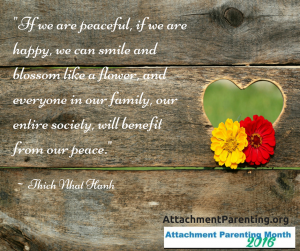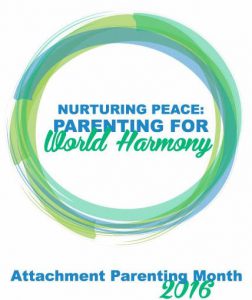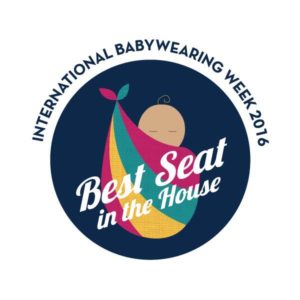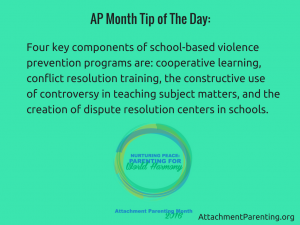API honors parents and caregivers as the ultimate peacemakers.
Children internalize the values we transmit over time through our own actions and interactions. Parenting infused with peace and harmony informs the responses of our future global leaders as they face conflict.
We aim to support parents in peaceful and harmonious impulses, so they might be reflected in future global conditions.
Parents and caregivers who foster peaceful relationships with their children make real contributions toward this global goal.
Peace and harmony can seem like a distant goal when technology constantly broadcasts world news to our wrist, the palm of our hands, our lap, or desk. Unprecedented access to the people, places, and events around the world is both wonderful and the cumulative stresses can silently build up and weigh on us without our awareness.
The relentless news cycle features conflict with rarely a hopeful note. Loud discord streams continuously and is a pervasive presence in our social lives. Conflict and outrage are regularly stirred in this reactionary stew where micro-aggression, triggers, and general incivility feel like inescapable behavioral norms.
Our success as a species is based on our social dependency, which in turn ensures that conflicts are a regular feature of our lives. It’s impossible to live with so many different fellow humans and avoid conflict.
The good news is something we don’t often hear: We’re not predisposed to violence. Moreover, violence is not the only or natural result of being a social species. Peace can be our response, our way of life, but we must continuously and consciously choose it so that it becomes a well-worn groove.
Most of us have the ability to make choices about our behaviors and learn different behaviors, but being able to does not mean that change is easy or quick.
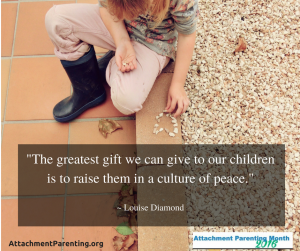 Children imitate and learn new things with surprising ease, so we can intuitively understand how peace and harmony in the home can lead children to rely on peaceful interactions over time. These are lifetime learning experiences that, when internalized, can persist across generations. And this is our motivation and incentive to keep seeking and trying peaceful and harmonious parenting.
Children imitate and learn new things with surprising ease, so we can intuitively understand how peace and harmony in the home can lead children to rely on peaceful interactions over time. These are lifetime learning experiences that, when internalized, can persist across generations. And this is our motivation and incentive to keep seeking and trying peaceful and harmonious parenting.
The advent of instant access to everything has shifted the ground under our feet. The frequency and degree of our exposure to violence has increased dramatically in just a few years. A cultural acceptance of violence and, in some cases, even glorification of it can have the effect of acceptance. It’s not that we like it necessarily: It’s just that it’s our new normal.
The overwhelming focus on negative aspects of life and conflict in the news colors our perception as well and can either numb or desensitize us or increase our general anxiety load, or leave us feeling helpless over events outside our control.
This October, during AP Month, we’re working to surround parents in peace and harmony. We aim to support parents in building family lives and parent-child relationships that are as peaceful and harmonious as possible. We’ll discover ways to cope and counterbalance the effects of negativity and uplift and honor the positive, hopeful, loving, and secure aspects of our world.
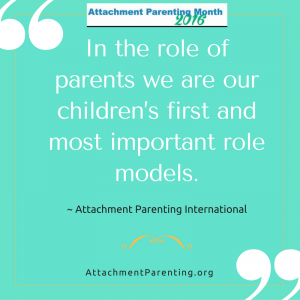 Parenting toddlers who refuse to eat or sleep or (fill in the blank) seem a far cry from world peace and harmony, but we invite you to examine and explore the connections. It may not feel like it in any given moment, but cumulative parent-child interactions become an influence for good that is greater than a collection of moments when we managed to get out the door on time.
Parenting toddlers who refuse to eat or sleep or (fill in the blank) seem a far cry from world peace and harmony, but we invite you to examine and explore the connections. It may not feel like it in any given moment, but cumulative parent-child interactions become an influence for good that is greater than a collection of moments when we managed to get out the door on time.
These days, when we have to work a little harder to surround ourselves with sustaining goodness, API helps parents tip the balance.
The Reality
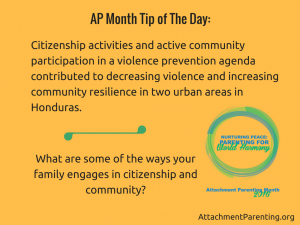 Statistics from The Peace Alliance and WHO we’d like to turn around:
Statistics from The Peace Alliance and WHO we’d like to turn around:
- If violence containment spending were represented as a discrete industry, it would be the largest industry in the U.S. economy — larger than construction, real estate, professional services, or manufacturing.
- If violence containment spending were represented as a discrete national economic entity, it would be the 7th-largest economy in the world — only slightly smaller than the UK economy.
- Violence containment spending is 4 times higher than the national defense budget.
- Public sector spending on violence containment spending accounts for 10.8% of GDP while private sector spending is 4.2% of GDP.
- If U.S. federal violence containment spending was reduced by 5% each year for 5 years, the $326 billion saved funds would be sufficient to entirely update the energy grid, rebuild all levies, and renew the nation’s school infrastructure.
Everyday Conflict
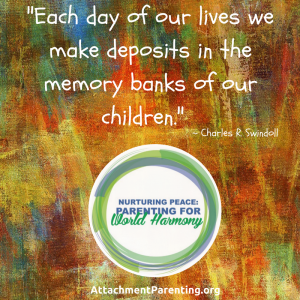 The impact of conflict in our daily lives generates a feeling that’s hard to escape:
The impact of conflict in our daily lives generates a feeling that’s hard to escape:
“As I get caught up in the opinions and harsh words being thrown around Facebook and other social media outlets, I can’t help but think about the message we are trying to make a reality in our home. And I wonder what would happen if we, as adults, stopped shouting long enough to listen and dropped our pride long enough to learn from the person who’s speaking.” ~ Storyline
Domestic Violence
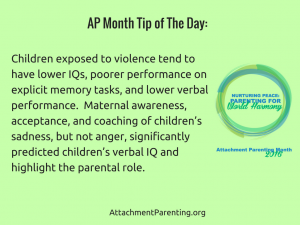 Domestic violence is a reality for many families and children and many dedicated professionals work to change this. The more support we build for families and communities in peace, the less prevalent intimate violence will be over time.
Domestic violence is a reality for many families and children and many dedicated professionals work to change this. The more support we build for families and communities in peace, the less prevalent intimate violence will be over time.
More than 5 million children are exposed to physical domestic violence each year. We know from the ACE study that for 95% of children exposed to domestic violence, there is also substance abuse, mental illness, neglect, abuse, or incarceration within their home.
Domestic violence can teach children negative and harmful lessons:
- Violence is normal
- Conflict is resolved by violence
- Abuse should be kept secret
- Negative behavior can be excused
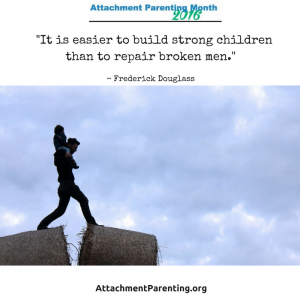 Statistically, we will all come into contact with children who are exposed to domestic abuse. As adults, we need to counteract the lesson of domestic violence with kindness, empathy, trust, and compassion. Just as we don’t expect children to know math before we teach them math, we need to help children develop healthy skills, such as conflict resolution, problem solving, emotion regulation, and calming strategies. Most importantly, we need to model and encourage healthy relationships.
Statistically, we will all come into contact with children who are exposed to domestic abuse. As adults, we need to counteract the lesson of domestic violence with kindness, empathy, trust, and compassion. Just as we don’t expect children to know math before we teach them math, we need to help children develop healthy skills, such as conflict resolution, problem solving, emotion regulation, and calming strategies. Most importantly, we need to model and encourage healthy relationships.
Media
Media is pervasive and may play a role:
“‘TV teaches people that aggressive behavior is normative, that the world around you is a jungle when it’s actually not so.’ In fact, research has shown that the more television a person watches, the more likely he or she is to believe that ‘most people would take advantage of you if they got a chance.'”
“In the United States, exposure to media violence is becoming an inescapable component of children’s lives. With the rise in new technologies, such as tablets and new gaming platforms, children and adolescents increasingly are exposed to what is known as ‘virtual violence.’ This form of violence is not experienced physically; rather, it is experienced in realistic ways via new technology and ever more intense and realistic games. The American Academy of pediatrics continues to be concerned about children’s exposure to virtual violence and the effect it has on their overall health and well-being. This policy statement aims to summarize the current state of scientific knowledge regarding the effects of virtual violence on children’s attitudes and behaviors and to make specific recommendations for pediatricians, parents, industry, and policy makers.”
Hope
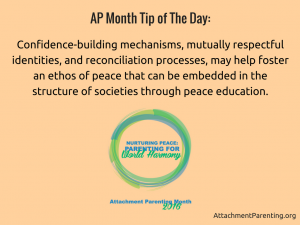 While we need to be clear-eyed about the challenges, we work this month to promote a season of hope and agency.
While we need to be clear-eyed about the challenges, we work this month to promote a season of hope and agency.
There are many organizations who are working to turn things around on a global level:
“Global philanthropic support for efforts to prevent, mitigate, and resolve conflicts totaled $283 million in 2013… 288 foundations awarded nearly 2,000 grants in support of more than 1,200 organizations working for peace, justice, diplomacy, and national and global security, from conducting research on the prevention of nuclear terrorism to supporting citizen journalism in Egypt. The top 15 peace and security funders…provided 67% of the $283 million awarded in 2013, and 70% of the funders included in the study awarded less than $250,000 each, and 37% gave less than $50,000.” ~ Philanthropy News Digest
And there are organizations that work on multiple levels including community and individual, even parenting, such as:
- Attachment Parenting International (API)
- National Partnership to End Interpersonal Violence Across the Lifespan (NPEIV)
- Nonviolent Communication (NVC)
Peace More Than War
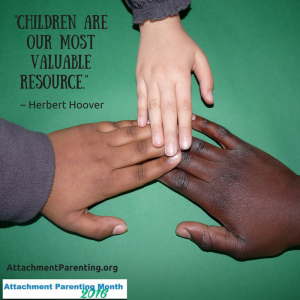 The good news is that the news may be more good than bad if we look at the biggest picture:
The good news is that the news may be more good than bad if we look at the biggest picture:
“Humans are more often at peace than at war; we cooperate more than we conflict. In fact, there is mounting evidence that cooperation may be a central facet in explaining our success as a species. On the other hand, this does not mean we are egalitarian, nonviolent pacifists. Human nature is neither simple nor linear. Our core adaptation is one of cooperation, but we can and do compete — a lot — and often use aggression to do so.” ~ Being Human
Or these articles:
- “The World is Not Falling Apart” on Slate
- The Council of Foreign Relations’ “Human Security Report”
API’s Stance
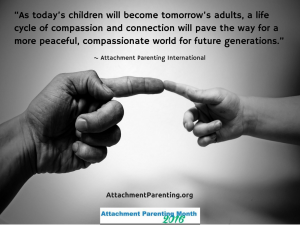 Suffering still persists without a doubt, and violence is a fact for far too many of us. But this October, we’ll work to support parents and families find and share the peace because:
Suffering still persists without a doubt, and violence is a fact for far too many of us. But this October, we’ll work to support parents and families find and share the peace because:
“Ultimately this is about showering people in love—even the people who we so strongly disagree with.” ~ Storyline
Read the AP Month 2016 Research Paper in its entirety, including links to specific studies, on AP Month Central.

